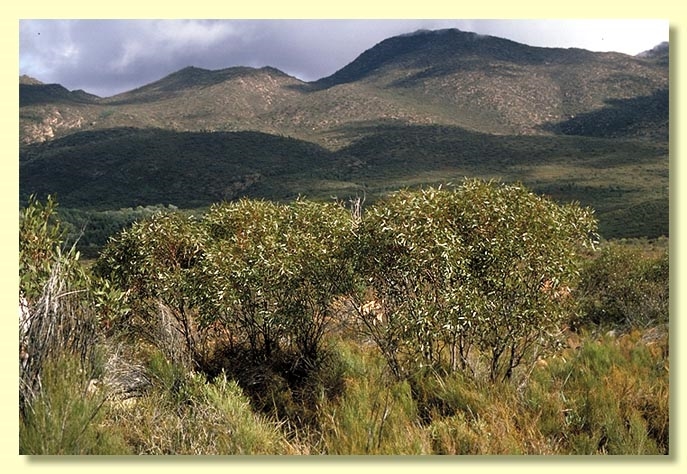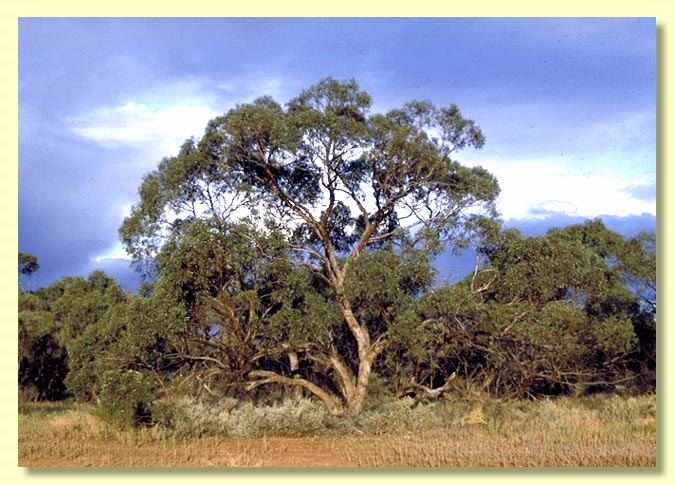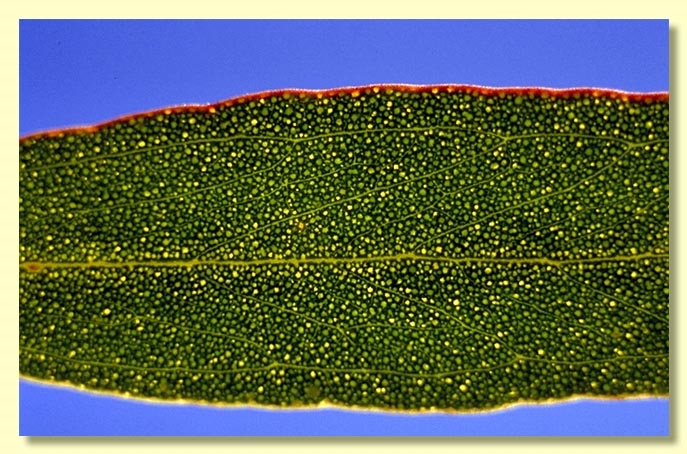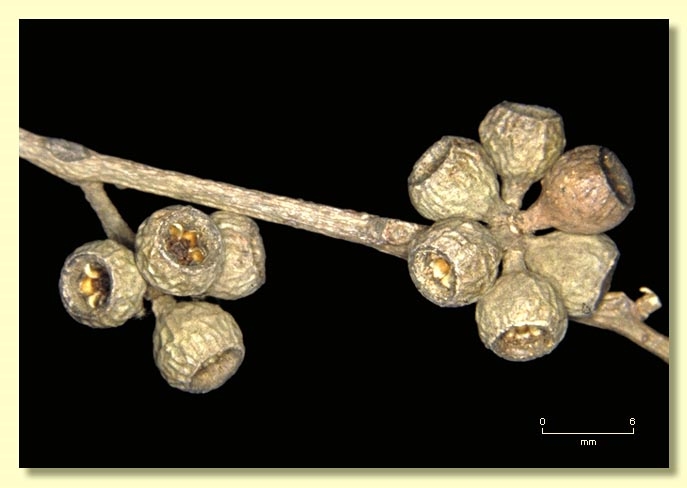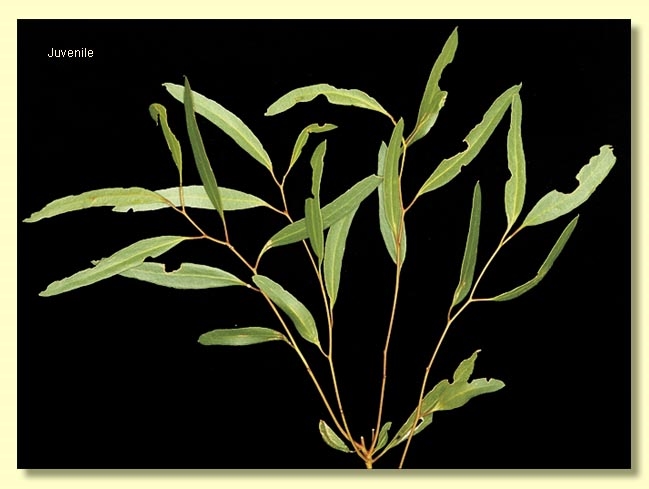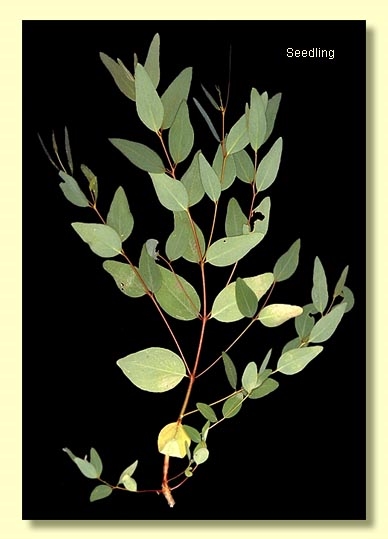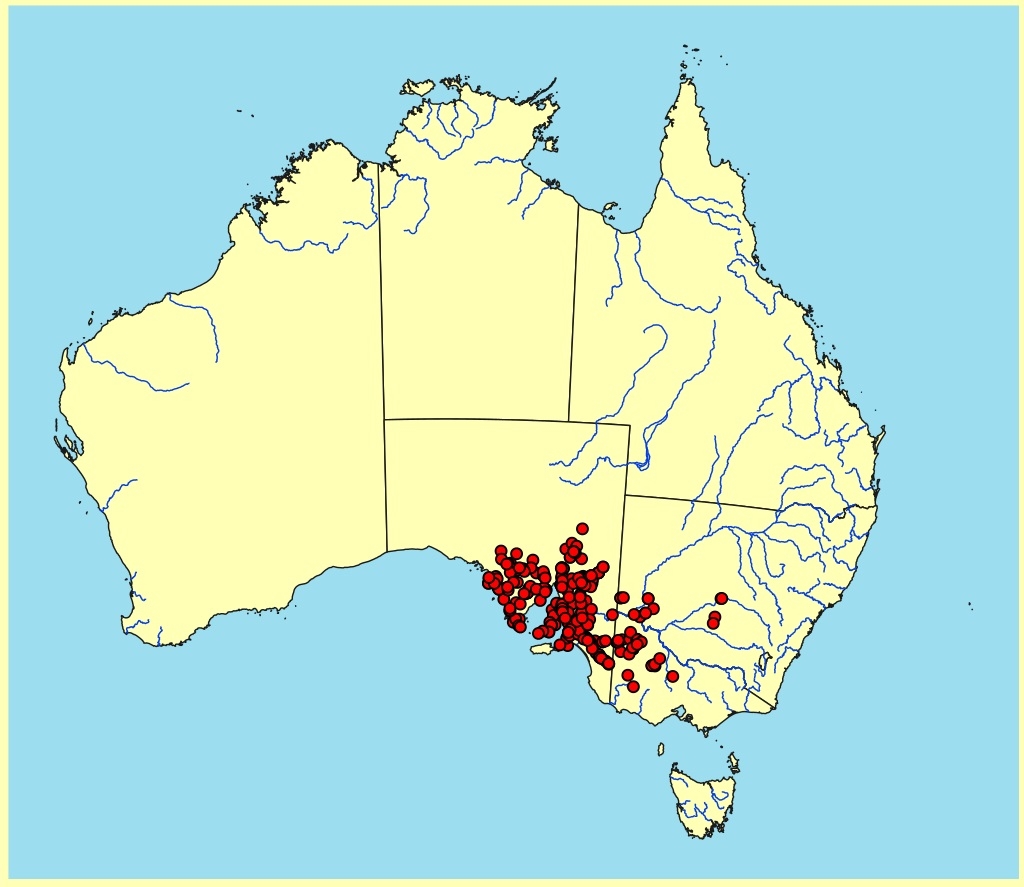Euclid - Online edition
Eucalyptus porosa
Eucalyptus | Symphyomyrtus | Adnataria | Apicales | Buxeales | Continentes
Eucalyptus calcicultrix var. porosa (F.Muell. ex Miq.) Blakely, Key Eucalypts 224 (1934). T: Flinders Ra., S.A., F.Mueller s.n..
Eucalyptus odorata var. calcicultrix F.Muell. ex Miq., op. cit. 129; Eucalyptus calcicultrix (F.Muell. ex Miq.) F.Muell. ex Blakely, Key Eucalypts 224 (1934). T: near Adelaide, S.A., F.Mueller s.n.; iso: AD, MEL, NSW.
Bark rough on the short trunk and larger branches of trees, and on lower stems of mallees, box-type, dark grey to dark brown-grey or whitish grey; smooth bark whitish or grey; branchlets with or without oil glands in the pith.
Juvenile stem rounded in cross-section; juvenile leaves always petiolate, opposite for ca 4 nodes then alternate, ovate to lanceolate, 5.5–9 cm long, 1.2–2.2 cm wide, base tapering to petiole, green.
Adult leaves alternate, petiole 0.5–1.8 cm long; blade lanceolate, 5–12 cm long, 0.8–2.3 cm wide, base tapering to petiole, margin entire or subcrenulate, concolorous, glossy, green, side-veins acute, sparsely to moderately reticulate.
Inflorescence rarely terminal compound, more commonly with some compound clusters or simple umbels in leaf axils, peduncles 0.2–1.2 cm long, buds 7 per umbel, pedicels 0–0.7 cm long. Mature buds ovoid, 0.4–0.7 cm long, 0.3–0.5 cm wide, green, scar absent (both outer and inner opercula shed at flowering), operculum conical to rounded or slightly beaked, stamens inflexed or irregularly flexed, all fertile, anthers adnate, globoid, dehiscing by lateral pores, style long, stigma blunt, locules 4 or 5(6), the placentae each with 4 vertical ovule rows. Flowers white.
Fruit on pedicels 0–0.7 cm long, barrel-shaped or truncate-globose, 0.4–0.7 cm long, 0.4–0.8 cm wide, staminal ring often persistent on newly mature fruit but ultimately falling intact, disc descending, valves 4 or 5(6), near rim level or enclosed.
Seeds black or brown, 0.8–1.5 mm long, ovoid or flattened-ovoid, dorsal surface shallowly reticulate, hilum ventral.
Cultivated seedlings (measured at node 10): cotyledons reniform to oblong; stems in cross-section; leaves always petiolate, opposite for 2 to 8 nodes then alternate, ovate to broadly lanceolate or elliptical, 4–8 cm long, 1.5–3 cm long, green, becoming glossy.
Flowering has been recorded in January, May, July, September, October, November and December.
A mallee-box species or short-trunked tree widespread from the Gawler Range and Eyre Peninsula eastwards through the typical mallee scrubs of South Australia and north-western Victoria, becoming more scattered in south-western New South Wales north and east of Wentworth extending as far as the Euabalong district in the central-west; often on shallow limestony soils and around soaks, but also on stony hills. It is recognised by the rough bark, glossy green leaves with prominent oil glands, intramarginal vein distant from the leaf margin, pedicellate buds usually in axillary clusters and fruit with 4 or 5(6) valves. It can be a tall mallee compared with nearby species.
E. porosa shows some affinity with E. leucoxylon by the prominent staminal ring that remains on the developing fruit after the stamens have fallen.
Eucalyptus porosa belongs in Eucalyptus subgenus Symphyomyrtus section Adnataria (the boxes) because the buds have two opercula, ovules are in four rows, seeds are flattened-ovoid, cotyledons are reniform, and anthers are rigid on the staminal filaments. Within section Adnataria, E. porosa is part of a subgroup, series Buxeales subseries Continentes, further distinguished by having buds that retain the outer operculum until flowering time when both opercula are shed together. Most species in this group are from eastern Australia and have all stamens fertile and are woodland trees of hills and plains, often dominant in the landscape, viz. E. albens, E. moluccana, E. microcarpa and E. woollsiana. Others, viz. E. viridis, E. polybractea, E. froggattii, E. odorata, E. albopurpurea, and E. porosa, are mallees, some of them also occurring as small trees occasionally.

